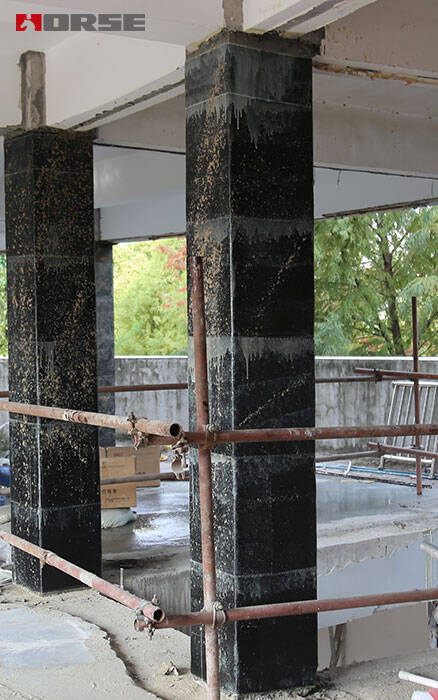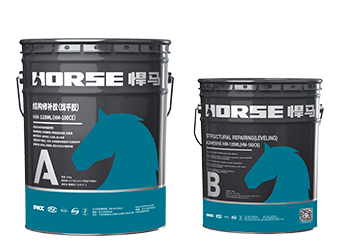Soluciones
La gama de negocios de construcción de caballos se extiende a todo el mundo y sirve a miles de clientes con productos, orientación técnica especializada en construcción, y somos testigos del reinicio de la marca china con ellos.
Carbon fiber fabric reinforced concrete columns can change the axial stress state of concrete into three-dimensional stress state, and the bearing capacity and deformation capacity of confined concrete can be improved.

Reinforcement mechanism analysis of reinforced concrete column with carbon fiber fabric
1.1. Carbon fiber reinforced polymer(CFRP) fabric
Carbon fiber fabric is generally a continuous fiber with a diameter of 5-20 micron. The base material is composed of resin and curing agent. The carbon fiber is soaked with resin (internal reinforcer). When the resin is cured, a carbon fiber reinforced polymer (CFRP) fabric is formed.
The density is small, 1/6 for ordinary steel.
The tensile strength is about 4~6 times that of the ordinary steel bar.
Corrosion resistance is good, strength is not affected by acid and alkali corrosive medium.
Non magnetism does not affect the propagation of electromagnetic signals.
Fatigue resistance is excellent and fatigue life is generally higher than steel.
The coefficient of temperature variation is equivalent to that of concrete.
The elastic modulus is similar to that of steel.
The limit elongation is 1%.
1.2 The principle of carbon fiber fabric reinforced concrete columns.
When reinforced concrete columns are subjected to axial compression, the members are caused by lateral expansion with very small limit value. If lateral constraints can be created around the members to prevent such lateral expansion of the compressive members, so as to improve the compressive capacity and deformation capacity of the members.
Carbon fiber fabric reinforcement of reinforced concrete columns is to produce restraint between the column concrete and the carbon fiber fabric reinforcement band, (the interaction between them is called interface restraint stress). The core concrete of plastic zone is in the three direction stress state under the action of transverse interface constraint stress. The ultimate compressive strain and load-bearing capacity of reinforced concrete columns are higher than those under unidirectional loading, and the ductility deformation and energy dissipation capacity of reinforced concrete columns are larger when the flexural bearing capacity of columns is not significantly reduced without considering the effect of instability.
1.3 the stress distribution of reinforced concrete columns under the action of wrapping with carbon fiber fabric.
1.3.1 The ultimate ultimate axial compressive strength of rectangular columns enclosed by carbon fiber fabric is much lower than that of circular columns due to the axial tensile stress of carbon fiber fabric formed by the transverse restraint of CFRP on reinforced concrete columns, but the bending resistance of carbon fiber fabric is very weak (generally not considered). The lateral restraint at the center of the rectangular column edge is weak and the lateral stress concentration restraint at the corner is large. The lateral restraint stress of carbon fiber fabric on the reinforced concrete column can increase rapidly only when the lateral plastic deformation occurs at the column edge.
1.3.2 since the constraint of carbon fiber fabric on reinforced concrete columns is interface constraint, only when the concrete expands outward and laterally (resulting in plastic deformation) can carbon fiber fabric generate constraint stress on the concrete.
In the first stage, the axial compressive stress of concrete is small, the transverse deformation is small, and the CFRP force is small. In the second stage, with the increase of load, the deformation of column concrete increases, the circumferential stress of carbon fiber fabric increases significantly, and the circumferential restraint force increases rapidly until CFRP reaches its ultimate tensile strain. The increasing extent of the restrained stress and strain of CFRP on concrete is related to the specifications of carbon fiber fabric, bonding forms and bonding layers, which should be determined by experiments.

2 carbon fiber fabric reinforced concrete column technology and construction points
2.1. Application scope and working condition requirement
Carbon fiber fabric reinforcement of reinforced concrete columns is suitable for cylindrical or small section rectangular columns (section edge length is generally less than 800 mm), which can greatly improve the axial load-bearing capacity of reinforced concrete columns under unstable conditions. The precondition of reinforcement is that the core concrete of the member is not destroyed, and has certain bearing and deformation capacity.
2.2 key points for strengthening construction by carbon fiber fabric
2.2.1. When reinforced concrete columns are unloaded before reinforcement, there is strain lag between the outer CFRP and the surface of concrete columns when the concrete members are wrapped with carbon fiber fabric under load. It often happens that the concrete which has not been pulled apart by carbon fiber fabric is crushed. This effect makes the reinforcement effect of CFRP reduce and can not give full play to the high tensile performance of carbon fiber fabric.
2.2.2. The surface repair of concrete members is very important, which directly affects the transverse restraint effect of carbon fiber fabric on concrete. The radius of the corner chamfer of the rectangular column should not be less than 20 mm, and the side of the column should be repaired into an external convex surface to reduce the concentrated stress of carbon fiber fabric at the corner.
2.2.3. High quality carbon fiber fabric and adhesive must be selected. Strict process quality control should be carried out in construction and the matching of fiber cloth and adhesive should be ensured.
Puede encontrar cualquier cosa que necesite, confíe en probar estos productos y encontrará la gran diferencia después de eso.

Tejido de fibra de carbono unidireccional de alta resistencia para refuerzo de compuesto de polímero reforzado con fibra (FRP).

Adhesivo de nivelación de fibra de carbono de buena tixotropía para la reparación de superficies de concreto

Impregnación y pasta de componentes reforzados de superficie y productos de fibra.